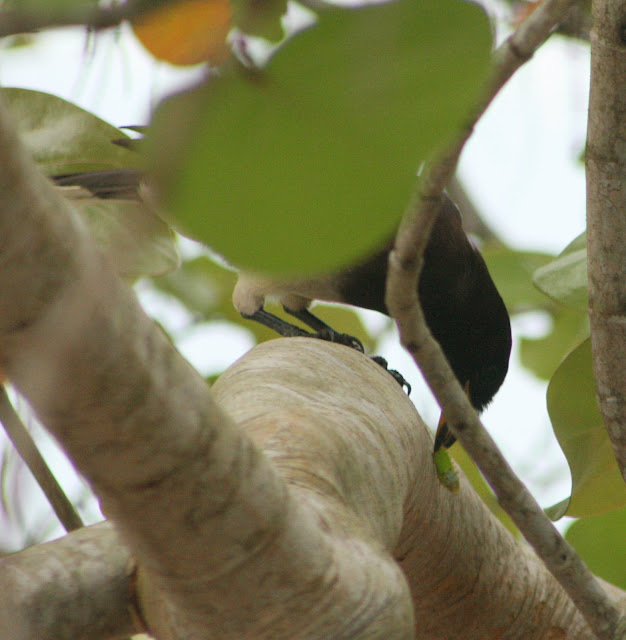We had some green plantains, so Dennis decided to make mofongo. For those of you not familiar with plantains, they look like bananas on steroids; which isn't surprising since they are close relatives of bananas. Unlike bananas, you can't eat plantains raw. But there are so many things you can make from plantains. I haven't met a plantain I didn't like. ;-) You use green plantains to make savory dishes, like mofongo and tostones, yellow plantains to make some dessert-type dishes as the starch starts to turn to sugar, and fully ripe black plantains to make other things I haven't tried yet. So far I have eaten our plantains before they got that far!
So Dennis set out to make mofongo, which he had never made before. I have eaten it several times and really enjoyed it. If there are any mofongo purists reading this, you may want to avert your eyes from the upcoming description! Every recipe we have seen for mofongo calls for bacon or other fatty pork. I thought this would be a problem for Dennis since he does not eat red meat; he only eats fish, shellfish, or poultry. So I was surprised when he bought real pork bacon for this recipe instead of turkey bacon which he could not obtain. I knew then that he was determined to make real mofongo. So much for good intentions. I helped him peel the green plantains which he then sliced into 2 inch thick sections before frying them in deep oil. For the first batch, he had the temp too high or cooked them a little too long, because the outside got hard and crispy. The next ones were a little better, but still too hard. We used them any way. The next step calls for smashing the cooked plantains with oil and garlic and then add in the crumbled bacon to make something akin to very dry and lumpy mashed potatoes. This was difficult to do with the over-cooked plantains, but we persevered and added extra oil to compensate for the dryness.
Normally mofongo is served in large balls formed from the mashed plantains. Sometimes the balls are stuffed with other meat or fillings. Ours was still too dry so we added some cooked calaloo (sort of like spinach but tropical) and mushrooms to try to make it more moist. It tasted pretty good at this point, but we planned to eat it the next day, so Dennis put in the fridge. When he got it out the next day it was drier than ever! The chunks of plantain were hard and stiff, totally inedible. So I suggested that he steam it. He did and it actually worked, although I don't think the end product actually qualifies as mofongo, it did taste pretty good. But it tasted best when stuffed in those peppers with brie cheese. We will explore that taste combination in future efforts, but will try for a more traditional mofongo first.
We were sitting on the veranda (that's where we are most of time, it seems) and I say a brown jay on a palm frond, which seemed unusual. It was hopping along the rib so I got some photos of it.
 |
| What is the jay doing on the palm? They usually hang out in the seagrape or tropical almond tree. |
 |
| Yes, I'm looking at you! |
It joined its sibling on another frond and the sibling (to the rear) had something in its beak.
 |
| You can see a small out of focus green thing in the jay's beak. |
 |
| The jay started dragging the green back and forth along the leaflets of the palm frond and carried on for some time. |
It finally dawned on me that it was either trying disarm a wasp or perhaps scrape stinging hairs off a caterpillar. So I went out to see what I could find on the palm fronds. I found one large caterpillar about 2 inches long on the underside of a palm frond.
 |
| The caterpillar was very handily located just over my head. My telephoto lens was no use; I had to go back in for the normal lens. |
I took photos from as many angles as possible.
 |
| I can't tell which end is which. |
 |
| Look at all those spines. |
 |
| Is this the front or the rear? |
 |
| Beautiful colors. |
I was going to watch it throughout the day to see if I could tell which end is which, but within a couple of hours, this one was dinner for a brown jay. I'll keep an eye out for others and also try to key this one out. Hope to have an update soon.















































